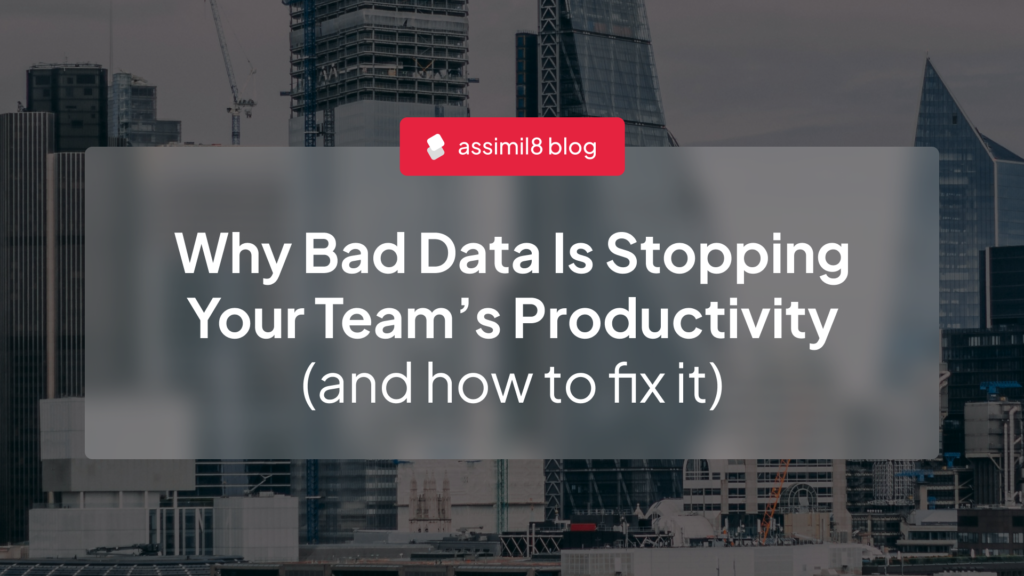When we talk about poor data quality, the focus is usually on the bottom line: lost revenue, missed opportunities, inaccurate reports—you know the drill.

But there’s another, often overlooked, consequence of bad data… the toll it takes on your team.
Think about how often you’ve rolled out the old trope that your employees are your greatest asset.
They’re the people running reports, making decisions, and trying to drive the business forward. But what happens when they’re forced to work with inaccurate, inconsistent, or incomplete data? Frustration builds, morale dips, and the likelihood of errors skyrockets.
With that in mind, let’s look at the human side of poor data quality and see if we can provide some ways you can counteract the impact it has on your greatest asset.
How Bad Data Leads to Employee Frustration and Burnout
Imagine spending hours sifting through data that you can’t trust. You pull a report, only to realise that the numbers don’t add up. Maybe they’re incomplete, maybe they’re outdated, or maybe they just don’t seem accurate. Either way, you’re left second-guessing your work and redoing tasks that should have been simple.
This is the reality employees face when they’re forced to work with poor data. Over time, this constant struggle leads to frustration and burnout.
In this article, we’ll give you four real-world examples of how bad data has impacted employees.
Here’s the first:
The Rework Loop
Sarah is a marketing manager for a small co-working office space in the North of England. She spends hours crafting a targeted email campaign, only to realise that 20% of the emails bounce back because the customer data in the system is outdated or incorrect. This isn’t the first time it’s happened, either—it’s a pattern that’s been repeated over and over.
Each time, Sarah has to go back, clean up the data, and start again. It’s demoralising, especially when her time could have been spent creating new strategies to drive new businesses into the co-working space. When employees like Sarah have to spend time cleaning up bad data, their productivity suffers. Worse, it chips away at their job satisfaction and increases the risk of burnout.
The Impact of Poor Data on Collaboration and Communication
Another side effect of poor data quality is the strain it places on collaboration between departments. If different teams are working with inconsistent data, it can lead to miscommunication, wasted effort, and even conflict.
We’ve all heard stories about how sales and marketing teams butt heads, but they’re not the only ones. Ready for real-world example two?
The Blame Game
We worked with a client whose sales and finance teams were collaborating on a forecast report.
The sales team pulled data from Salesforce, which showed strong numbers for the upcoming quarter. Finance, however, pulled data from another system, which showed a significant shortfall in sales revenue.
The result? Miscommunication, confusion, and frustration. Each department believed they were working with the correct numbers, and the situation quickly devolved into a blame game. Instead of collaborating to solve the problem, employees pointed fingers, further fracturing the working relationship between teams.
Poor data did more than spark a war; it undermined the trust between departments and, ultimately, the tools they used. Can you imagine trying to sign off Salesforce for another year? The pushback from finance is going to make it practically impossible.

How Poor Data Quality Creates a Cycle of Errors
When data is unreliable, employees are forced to make assumptions or manually fill in the gaps.
Not only does this increase the chances of making mistakes, but it also leads to more errors down the line as inaccurate data continues to be used. This brings us nicely to the third example.
The Domino Effect
We met Stacey in 2017. She was in charge of inventory management for an online fashion retailer.
The system said they had 500 units of a product in stock, but when Stacey went to fulfil the order, she found that the actual count was way lower. Why? Because the data wasn’t updated when products were returned or sold through different channels.
This wasn’t the first time it happened, and it inadvertently set off a chain reaction.
Orders got delayed, customer complaints increased, and Stacey had to spend time reconciling the numbers. Meanwhile, sales and customer service are trying to manage expectations with inaccurate information, leading to frustrated customers and employees.
Poor data didn’t just cause one mistake—it caused a domino effect of errors and inefficiencies that impacted multiple teams across the business.
How Improving Data Quality Enhances Team Efficiency and Satisfaction
Don’t worry. The examples we’ve given so far all had happy endings. We worked with each organisation to develop data quality strategies that focused on the biggest issues causing the most pain.
When employees have access to clean, reliable data, everything changes.
They can focus on their core tasks rather than spending time fixing errors or reconciling numbers. Collaboration between departments improves because everyone is working from the same source of truth. Most importantly, employee morale gets a much-needed boost because they feel empowered to do their jobs effectively.
For our final example, let’s revisit one of our demoralised examples.
The Empowered Team
Let’s go back to Sarah, our marketing manager. After implementing a data quality solution that regularly audited and cleansed her CRM of choice, Sarah now works with accurate, up-to-date contact information.
This means that her campaigns now run smoothly, with fewer bounced emails and better engagement. Instead of reworking old campaigns, Sarah was able to focus on creating new strategies that saw more people opening her emails than ever before. From a + 20% bounce rate, she was now seeing bounce rates drop to below 3%. With more people seeing her campaigns, the co-working space saw its best uptake in months and is now running at capacity, with plans to expand in the new year.
This is the difference reliable data can make. Employees like Sarah are able to thrive when they’re empowered with the right tools and information.
Don't Let Bad Data Frustrate Your Team
Think back to all those times when your team failed to meet their targets. Now ask yourself, was that due to lack of effort or because the tools and information they had at their disposal weren’t fit for the task?
You know how much effort your team puts in every day. Don’t let poor data quality be the reason they feel frustrated, burnt out, or overwhelmed.
At assimil8, we specialise in data quality solutions that empower your employees with accurate, reliable data. When your team has the right data, they can focus on what matters—driving your business forward.
Ready to make a change?
Contact us to learn how we can help you overcome bad data and create an environment where your team can thrive.









